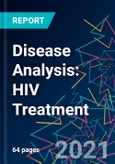Disease Overview
- The HIV treatment market in the US and five major European markets (France, Germany, Italy, Spain and the UK) is expected to continue to expand through to 2026, driven primarily by increases in disease prevalence and continued uptake of Gilead’s Biktarvy and ViiV Healthcare’s portfolio of two-drug regimens. Uptake of new premium-priced therapies (Rukobia and lenacapavir) in heavily treatment-experienced individuals will also drive growth, though their impact will be limited by the relatively low number of patients in the salvage setting. However, a plethora of products undergoing patent expiry across the forecast period will tip the market into decline from 2027, particularly Descovy, which is the preferred nucleos(t)ide reverse transcriptase inhibitor (NRTI) backbone, as physicians and payers will be provided with the ability to construct lower-cost once-daily regimens with generic Descovy and a generic third antiretroviral agent (such as dolutegravir, which will lose exclusivity in the US in 2027).
- Integrase strand transfer inhibitor (INSTI)-based regimens have become the top drug class due to their excellent efficacy and tolerability profiles as well as their very high barriers to resistance. Both US and EU guidelines now favor INSTI-based regimens as initial “recommended” regimens, which has driven a steady decline in the market share of protease inhibitor (PI)- and non-nucleoside reverse transcriptase (NNRTI)-based regimens in the first-line setting in recent years. PIs suffer from the requirement for co-administration with a pharmacokinetic boosting agent, which increases the risk of drug-drug interactions and adverse events, while NNRTIs suffer from low barriers to resistance. In the maintenance setting, the recent launches of Juluca, Dovato, and Cabenuva will further drive consolidation to INSTI-based regimens by offering patients the opportunity to simplify their treatment regimens from three drugs to two.
- Gilead's flagship single-tablet regimen (STR) Biktarvy will continue to experience strong growth through to at least 2025. Biktarvy outpaced rival STRs to gain market leader status in 2020, with sales amounting to $7.3bn. Further success in the HIV market will primarily be driven by patients switching over from Gilead’s older STRs (Genvoya, Stribild, Atripla, Complera, and Odefsey), its continued uptake in treatment-naïve patients, increasing HIV prevalence, and price rises in the US. While Biktarvy has suppressed its main rival Triumeq, the drug will face competition from other assets in ViiV Healthcare’s portfolio, most notably two-drug regimens Dovato, Juluca, and Cabenuva. Additional competition will come in 2025 following the launch of low-cost generics for Descovy, which makes up the NRTI backbone of Biktarvy. Coupling generic Descovy with an INSTI such as Tivicay will allow physicians to make their own cheaper three-drug regimens.
- ViiV Healthcare has maintained its second-place position in the HIV treatment market and is likely to grow its revenues due to new INSTI-based drug launches. Despite a continued decline for the company’s flagship three-drug regimen Triumeq, a shift in focus to the recently launched two-drug regimens Cabenuva, Dovato, and Juluca will be key in growing ViiV Healthcare’s revenues. The two-drug regimens have the advantage of potentially improved long-term tolerability and safety, although this is unproven, as well as a lower cost, giving them a competitive advantage. While initial uptake was muted due to physician concerns over resistance generation, long-term data demonstrating that resistance generation is minimal should allay these concerns. The uptake of these drugs rose sharply between 2019 and 2020, with sales of Dovato increasing from $56m to $376m, and Juluca sales increasing from $376m to $495m. Cabenuva has the advantage of a once-monthly injectable dosing schedule (likely to be expanded to two-monthly post approval); however, it is expected to gain only a minority of market share because it must be administered as two separate intramuscular injections by a physician, which will be a deterrent to some patients as well as posing a logistical challenge for primary care physicians by increasing the number of patient visits required.
- Remaining unmet needs in the HIV space include longer-acting drugs, simplified dosing regimens, and more treatment options for heavily treatment-experienced patients. Initially, ViiV Healthcare’s two-drug regimens had a muted uptake due to a hypothetical lower barrier to resistance; however, uptake is now accelerating. Cabenuva, which has a once-monthly or two-monthly dosing regimen, has the benefit of being the first-to-market long-acting injectable (LAI); however, Gilead’s pipeline asset lenacapavir, which has a more attractive six-monthly dosing schedule, is likely to be a major challenger. Moreover, a partnership between Gilead and Merck & Co to develop a dual-combination therapy of islatravir/lenacapavir as a long-acting oral (LAO) and LAI is another major threat; however, at the earliest, an LAO and LAI for islatravir/lenacapavir will be launched in 2025 and 2027, respectively.
- With a minority of treatment-experienced patients generating resistance to multiple drug classes, there is a major unmet need for new mechanisms of action. There are three new drugs in late-phase development for the treatment of heavily treatment-experienced patients, namely lenacapavir (capsid inhibitor), islatravir/doravirine (reverse transcriptase translocation inhibitor), and Vyrologix (CCR5 inhibitor).
Table of Contents
OVERVIEW
DISEASE BACKGROUND
TREATMENT
EPIDEMIOLOGY
KEY REGULATORY EVENTS
LICENSING AND ASSET ACQUISITION DEALS
CLINICAL TRIAL LANDSCAPE
FUTURE TRENDS
RECENT EVENTS AND ANALYST OPINION
UNMET NEEDS
LIST OF FIGURES
LIST OF TABLES








